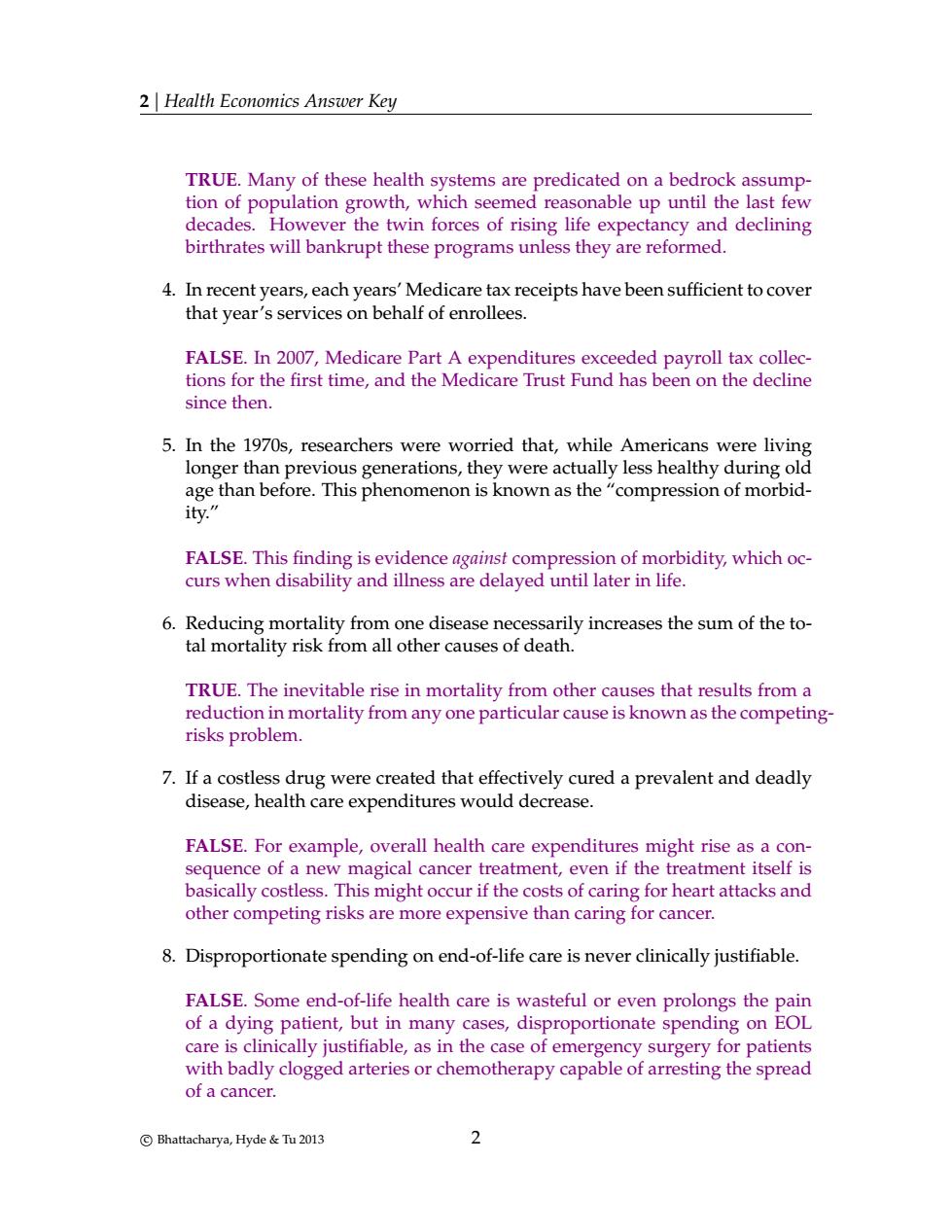正在加载图片...

2 Health Economics Answer Key TRUE.Many of these health systems are predicated on a bedrock assump ed reas sonable up until the last f ever the twin forces of rising life expectancy an declining birthrates will bankrupt these programs unless they are reformed 4.In recent years,each years'Medicare tax receipts have been sufficient to cover that year's services on behalf of enrollees. FALSE.I007,Medicare Part A expenditures exceeded payroll tax collec tions for the first time,and the Medicare Trust Fund has been on the decline since then. 5.In the 1970s,researchers were worried that,while Americans were living longer than previous generations,they were actually less healthy during old age than before.This phenomenon is known as the "compression of morbid- ity." FALSE.This findi vidence agai compre ion of morbidity,which oc- curs when disability and illness are delayed until later in life 6.Reducing mortality from one disease necessarily increases the sum of the to- tal mortality risk from all other causes of death TRUE.The inevitable rise in mortality from other causes that results from a reduction in mortality from any one particular cause is known as the competing risks problem 7.If a costless drug were created that effectively cured a prevalent and deadly disease,health care expenditures would decrease. FALSE.For example,overall health care expenditures might rise as a con- sequence of a new magical cancer treatment,even if the treatment itself is basically costless.This might occur if the costs of caring for heart attacks and other competing risks are more expensive than caring for cancer 8.Disproportionate spending on end-of-life care is never clinically justifiable FALSE.Some end-of-life health care is wasteful or even prolongs the pain of a dying patient,but in many cases,disproportionate spending on EOL of a cancer. Bhattacharya,Hyde &Tu2013 22 | Health Economics Answer Key TRUE. Many of these health systems are predicated on a bedrock assumption of population growth, which seemed reasonable up until the last few decades. However the twin forces of rising life expectancy and declining birthrates will bankrupt these programs unless they are reformed. 4. In recent years, each years’ Medicare tax receipts have been sufficient to cover that year’s services on behalf of enrollees. FALSE. In 2007, Medicare Part A expenditures exceeded payroll tax collections for the first time, and the Medicare Trust Fund has been on the decline since then. 5. In the 1970s, researchers were worried that, while Americans were living longer than previous generations, they were actually less healthy during old age than before. This phenomenon is known as the “compression of morbidity.” FALSE. This finding is evidence against compression of morbidity, which occurs when disability and illness are delayed until later in life. 6. Reducing mortality from one disease necessarily increases the sum of the total mortality risk from all other causes of death. TRUE. The inevitable rise in mortality from other causes that results from a reduction in mortality from any one particular cause is known as the competingrisks problem. 7. If a costless drug were created that effectively cured a prevalent and deadly disease, health care expenditures would decrease. FALSE. For example, overall health care expenditures might rise as a consequence of a new magical cancer treatment, even if the treatment itself is basically costless. This might occur if the costs of caring for heart attacks and other competing risks are more expensive than caring for cancer. 8. Disproportionate spending on end-of-life care is never clinically justifiable. FALSE. Some end-of-life health care is wasteful or even prolongs the pain of a dying patient, but in many cases, disproportionate spending on EOL care is clinically justifiable, as in the case of emergency surgery for patients with badly clogged arteries or chemotherapy capable of arresting the spread of a cancer. c Bhattacharya, Hyde & Tu 2013 2